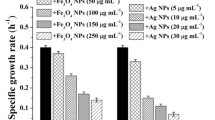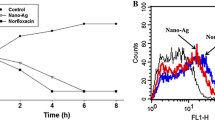Abstract
The evolution of antibiotics-resistant bacteria is considered a major concern. To explore promising antibacterial materials and clarify their unknown mechanisms, the mode of action of silver nanoparticles (AgNPs) against Salmonella enterica serotype typhimurium was investigated. We investigated the effect of AgNPs on the bacterial membrane. The N-phenyl-1-naphthylamine assay showed that the permeability of the outer membrane was not changed by treatment with AgNPs. The O-nitrophenyl-β-d-galactopyranoside assay showed that the inner membrane permeability increased as AgNPs concentration increased. Our results showed that AgNPs affected the inner membrane without outer membrane damage. Generally, antibiotic-induced reactive oxygen species (ROS) and changes in the Ca2+ gradient are known to contribute to bacterial cell death. Likewise, we detected that AgNPs induced the accumulation of ROS and intracellular Ca2+ depending on its concentration, using 2′,7′-dichlorodihydrofluorescein and Fura-2AM, respectively. At higher concentrations, no relationship between oxidative stress and bactericidal effects of AgNPs was confirmed through a cell viability assay and intracellular Ca2+ assay with antioxidant N-acetylcysteine. In this study, the inner membrane disruption followed by membrane dysfunction played a key role in the antibacterial activity of AgNPs against S. typhimurium. Contrary to the expected results, ROS do not influence growth inhibition of AgNPs.






Similar content being viewed by others
References
Bjelakovic G, Nikolova D, Gluud C (2013) Antioxidant supplements to prevent mortality. JAMA 310:1178–1179
Bootman MD, Rietdorf K, Collins T, Walker S, Sanderson M (2013) Ca2+-sensitive fluorescent dyes and intracellular Ca2+ imaging. Cold Spring Harb Protoc 2013: 83–99
Borges A, Ferreira C, Saavedra MJ, Simoes M (2013) Antibacterial activity and mode of action of ferulic and gallic acids against pathogenic bacteria. Microb Drug Resist 19:256–265
Bosetti M, Masse A, Tobin E, Cannas M (2002) Silver coated materials for external fixation devices: in vitro biocompatibility and genotoxicity. Biomaterials 23:887–892
Breuil J, Brisabois A, Casin I, Armand-Lefèvre L, Frémy S, Collatz E (2000) Antibiotic resistance in salmonellae isolated from humans and animals in France: comparative data from 1994 and 1997. J Antimicrob Chemother 46:965–971
Bush K (2012) Antimicrobial agents targeting bacterial cell walls and cell membranes. Rev Sci Tech 31:43–56
Cabeen MT, Jacobs-Wagner C (2005) Bacterial cell shape. Nat Rev Microbiol 3:601–610
Celsi F, Pizzo P, Brini M, Leo S, Fotino C, Pinton P, Rizzuto R (2009) Mitochondria, calcium and cell death: a deadly triad in neurodegeneration. Biochim Biophys Acta (BBA) 1787:335–344
Echave P, Tamarit J, Cabiscol E, Ros J (2003) Novel antioxidant role of alcohol dehydrogenase E from Escherichia coli. J Biol Chem 278:30193–30198
Epand RF, Maloy WL, Ramamoorthy A, Epand RM (2010) Probing the “charge cluster mechanism” in amphipathic helical cationic antimicrobial peptides. Biochemistry 49:4076–4084
Furuya EY, Lowy FD (2006) Antimicrobial-resistant bacteria in the community setting. Nat Rev Microbiol 4:36–45
Grigor’eva A, Saranina I, Tikunova N, Safonov A, Timoshenko N, Rebrov A, Ryabchikova E (2013) Fine mechanisms of the interaction of silver nanoparticles with the cells of Salmonella typhimurium and Staphylococcus aureus. Biometals 26:479–488
Hassett DJ, Imlay JA (2007) Bactericidal antibiotics and oxidative stress: a radical proposal. ACS Chem Biol 2:708–710
Huang E, Yousef AE (2014) The lipopeptide antibiotic paenibacterin binds to the bacterial outer membrane and exerts bactericidal activity through cytoplasmic membrane damage. Appl Environ Microbiol 80:2700–2704
Hussain SM, Frazier JM (2003) Involvement of apoptosis in hydrazine induced toxicity in rat primary hepatocytes. Toxicol In Vitro 17:343–355
Ibrahim EH, Sherman G, Ward S, Fraser VJ, Kollef, MH (2000) The influence of inadequate antimicrobial treatment of bloodstream infections on patient outcomes in the ICU setting. Chest J 118: 146–155
Jacobson J, Duchen MR (2004) Interplay between mitochondria and cellular calcium signalling. Mol Cell Biochem 256:209–218
Kim KJ, Sung WS, Suh BK, Moon SK, Choi JS, Kim JG, Lee DG (2009) Antifungal activity and mode of action of silver nano-particles on Candida albicans. Biometals 22:235–242
Kimbrough TG, Miller SI (2002) Assembly of the type III secretion needle complex of Salmonella typhimurium. Microbes Infect 4:75–82
Komaniecka I, Zamłyńska K, Zan R, Staszczak M, Pawelec J, Seta I, Choma A (2016) Rhizobium strains differ considerably in outer membrane permeability and polymyxin B resistance. Acta Biochim Pol 63:517–525
Koorts AM, Kruger MC, Potgieter CD, Viljoen M (2002) Intracellular free calcium in the neutrophils of maintenance haemodialysis patients. Clin Physiol Funct Imaging 22:285–294
Landolfo S, Politi H, Angelozzi D, Mannazzu I (2008) ROS accumulation and oxidative damage to cell structures in Saccharomyces cerevisiae wine strains during fermentation of high-sugar-containing medium. Biochim Biophys Acta (BBA) 1780:892–898
Le-Clech P, Chen V, Fane TA (2006) Fouling in membrane bioreactors used in wastewater treatment. J Membr Sci 284:17–53
Lewis DF, Adair CD, Robichaux AG, Jaekle RK, Moore JA, Evans AT, Fontenot MT (2003) Antibiotic therapy in preterm premature rupture of membranes: are seven days necessary? A preliminary, randomized clinical trial. Am J Obstet Gynecol 188:1413–1417
Li GY, Osborne NN (2008) Oxidative-induced apoptosis to an immortalized ganglion cell line is caspase independent but involves the activation of poly (ADP-ribose) polymerase and apoptosis-inducing factor. Brain Res 1188:35–43
Li L, Shi Y, Cheserek MJ, Su G, Le G (2013) Antibacterial activity and dual mechanisms of peptide analog derived from cell-penetrating peptide against Salmonella typhimurium and Streptococcus pyogenes. Appl Microbiol Biotechnol 97:1711–1723
Liu H, Du Y, Wang X, Sun L (2004) Chitosan kills bacteria through cell membrane damage. Int J Food Microbiol 95:147–155
Liu, X., Wang, N., Zhu, Y., Yang, Y., Chen, X., Fan, S., Chen, Q., Zhou, H., Zheng, J. (2016) Inhibition of extracellular calcium influx results in enhanced IL-12 production in LPS-treated murine macrophages by downregulation of the CaMKK-AMPK-SIRT1 signaling pathway. Mediators Inflamm 2016:1–15
Liu Y, Imlay JA (2013) Cell death from antibiotics without the involvement of reactive oxygen species. Science 339:1210–1213
Livermore DM (2012) Current epidemiology and growing resistance of gram-negative pathogens. Korean J Intern Med 27:128–142
Mann CL, Cidlowski JA (2001) Glucocorticoids regulate plasma membrane potential during rat thymocyte apoptosis in vivo and in vitro. Endocrinology 142:421–429
Mark LP, Prost RW, Ulmer JL, Smith MM, Daniels DL, Strottmann JM, Brown WP, Hacein-Bey L (2001) Pictorial review of glutamate excitotoxicity: fundamental concepts for neuroimaging. Am J Neuroradiol 22:1813–1824
Maurer-Jones MA, Mousavi MP, Chen LD, Bühlmann P, Haynes CL (2003) Characterization of silver ion dissolution from silver nanoparticles using fluorous-phase ion-selective electrodes and assessment of resultant toxicity to Shewanellaoneidensis. Chem Sci 4:2564–2572
Orrenius S, Zhivotovsky B, Nicotera P (2003) Regulation of cell death: the calcium–apoptosis link. Nat Rev Mol Cell Biol 4:552–565
Pal S, Tak YK, Song JM (2007) Does the antibacterial activity of silver nanoparticles depend on the shape of the nanoparticle? A study of the gram-negative bacterium Escherichia coli. Appl Environ Microbiol 73:1712–1720
Petrov V, Hille J, Mueller-Roeber B, Gechev TS (2015) ROS-mediated abiotic stress-induced programmed cell death in plants. Front Plant Sci 6:69
Rai MK, Deshmukh SD, Ingle AP, Gade AK (2012) Silver nanoparticles: the powerful nanoweapon against multidrug-resistant bacteria. J Appl Microbiol 112: 841–852
Rigel NW, Silhavy TJ (2012) Making a beta-barrel: assembly of outer membrane proteins in gram-negative bacteria. Curr Opin Microbiol 15:189–193
Rogers JV, Parkinson CV, Choi YW, Speshock JL, Hussain SM (2008) A preliminary assessment of silver nanoparticle inhibition of monkeypox virus plaque formation. Nanoscale Res Lett 3:129
Samuni Y, Goldstein S, Dean OM, Berk M (2013) The chemistry and biological activities of N-acetylcysteine. Biochim Biophys Acta (BBA) 1830:4117–4129
Sánchez E, García S, Heredia N (2010) Extracts of edible and medicinal plants damage membranes of Vibrio cholerae. Appl Environ Microbiol 76:6888–6894
Sattler R, Tymianski M (2000) Molecular mechanisms of calcium-dependent excitotoxicity. J Mol Med 78:3–13
Schacht VJ, Neumann LV, Sandhi SK, Chen L, Henning T, Klar PJ, … Bunge M (2013) Effects of silver nanoparticles on microbial growth dynamics. J Appl Microbiol 114:25–35
Sciacca MF, Kotler SA, Brender JR, Chen J, Lee DK, Ramamoorthy A (2012) Two-step mechanism of membrane disruption by Aβ through membrane fragmentation and pore formation. Biophys J 103:02–710
Sondi I, Salopek-Sondi B (2004) Silver nanoparticles as antimicrobial agent: a case study on E. coli as a model for gram-negative bacteria. J Colloid Interface Sci 275:177–182
Uttal WR (2014) Cellular neurophysiology and integration: an interpretive introduction. Psychology Press, New York
Yun DG, Lee DG (2016) Antibacterial activity of curcumin via apoptosis-like response in Escherichia coli. Appl Microbiol Biotechnol 100:5505–5514
Zarei M, Jamnejad A, Khajehali E (2014) Antibacterial effect of silver nanoparticles against four foodborne pathogens. Jundishapur J Microbiol 7(1):e8720
Acknowledgements
This work was supported by the National Research Foundation of Korea (NRF) grant funded by the Korea government (MSIP) (No. 2015R1A5A6001906).
Author information
Authors and Affiliations
Corresponding author
Ethics declarations
Conflict of interest
The authors declare that there are no conflicts of interest.
Rights and permissions
About this article
Cite this article
Seong, M., Lee, D.G. Silver Nanoparticles Against Salmonella enterica Serotype Typhimurium: Role of Inner Membrane Dysfunction. Curr Microbiol 74, 661–670 (2017). https://doi.org/10.1007/s00284-017-1235-9
Received:
Accepted:
Published:
Issue Date:
DOI: https://doi.org/10.1007/s00284-017-1235-9




